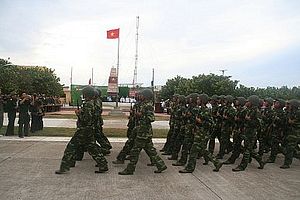Last week, the countries of the Mekong subregion kicked off another iteration of a key friendship border exchange program in Vietnam. Though the event was just one among many developments within the management of border relations between these countries, its significance nonetheless bears noting within the context of both regional developments on that front as well as Vietnam’s own priorities in this respect.
Over the past few years, the countries through which the Mekong River – one of the world’s largest, longest rivers – runs, have been working on ways to manage the opportunities and challenges that come from their shared borders, which extends from the highest levels of government down to local border guard units.
While the holding of such activities can conceal often fierce, lingering disagreements between some of these countries on border issues, they nonetheless remain a priority for these countries to varying degrees in order to manage such differences which can otherwise spill over into conflict as they have in the past. In Vietnam, for instance, the Vietnam Border Defense Force has played a critical role in preserving the country’s sovereignty and prosperity amid periods of conflict abroad as well as institutional contestation at home, and officials continue to emphasize this in domestic messaging as well.
One of the manifestations of border management in the Mekong context is the Friendship Border Exchange Program, which was first held back in 2014 among several mainland Southeast Asian states. The Program is just one among a series of other interactions between the countries as well as local border guard units.
Earlier this month, this aspect of regional collaboration was in the spotlight again with the third iteration of the Friendship Border Exchange Program. The Program was held in Vietnam from August 23 and 26, and it featured the participation of border guard forces from six countries: Vietnam, China, Cambodia, Laos, Myanmar, and Thailand.
The program itself consisted of several parts. This included a series of official meetings and ceremonies among the delegations held at the defense ministry’s headquarters, where the sides discussed ongoing issues with respect to border management as well as ways to expand bilateral and multilateral cooperation. But there were also other events tied to it as well, including a banquet held for international guests and a series of cultural activities by various countries.
Predictably, beyond the regional aspect of this interaction, it was also messaged domestically in Vietnam as part of events tied to a couple of key commemorations for the Vietnam Border Defense Force coming up in 2019. Vietnam is gearing up for both the 60th anniversary of the establishment of the Border Defense Force, which occurred on March 3, 1959, as well as the 30th iteration of All People’s Border Guard Day dating back to March 3, 1989. Vietnamese officials in their public statements made references to this point and also reinforced the significance of the Border Defense Force more generally.
Unsurprisingly few additional details were offered in the way of specifics regarding agenda items or next steps to be advanced for these regional states. But given the broader regional context over the next few months and into 2019, with states continuing to find ways to manage their border relations, and Vietnam itself set to unveil a series of developments tied to key anniversaries on this front, this space will remain one to watch.

































